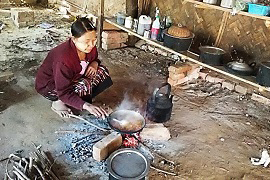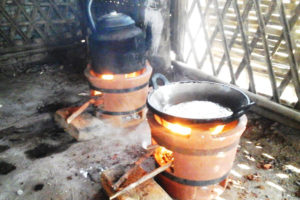Background
In Myanmar, as in many other developing countries, a large majority of households cook meals using biomass fuel such as agricultural waste, charcoal and firewood. In 2014, the housing census of Myanmar found that 70 percent of households, particularly in rural areas, use firewood for everyday cooking. The rural population mostly relies on wood-fuel from unsustainable logging of local forests, which has resulted in deforestation and depletion of natural resources, negatively impacting the environment. Myanmar has the third-highest annual rate of forest reduction in the world, with the rate of almost 2% (UN FAO 2010). The complete dependence on firewood also puts a burden on the people, especially women who have to invest time every single day to collect firewood.
 One practical solution to tackle the issue of heavy reliance on fire wood is to use more fuel-efficient wood-stoves in place of fuel wasting traditional three stones stoves. Since 1986, Myanmar’s Forest Research Institute (FRI) of the Forest Department has developed the Improved Cook Stove (ICS) program to solve this problem. FRI studied traditional cook stoves and some ICS were developed and tested. Based on the experience gained, stove design modifications were made and the ratio of clay to water was altered to improve the durability of the stove. The performance of the testing stove saved about 40% of fire wood and a significant amount of cooking time compared to that of the traditional cook stove. Later, the stove became known as A-1, a symbol of saving wood-fuel.
One practical solution to tackle the issue of heavy reliance on fire wood is to use more fuel-efficient wood-stoves in place of fuel wasting traditional three stones stoves. Since 1986, Myanmar’s Forest Research Institute (FRI) of the Forest Department has developed the Improved Cook Stove (ICS) program to solve this problem. FRI studied traditional cook stoves and some ICS were developed and tested. Based on the experience gained, stove design modifications were made and the ratio of clay to water was altered to improve the durability of the stove. The performance of the testing stove saved about 40% of fire wood and a significant amount of cooking time compared to that of the traditional cook stove. Later, the stove became known as A-1, a symbol of saving wood-fuel.
The fuel efficient A-1 cook stove is a ceramic, wood-burning cook stove designed with a special collar on top to fit a standard household cooking pot size of 9.4 inches as well as smaller size cooking pots. It is made from mud and other materials such as rice husk and saw dust, burned after drying to become ceramic. The basic structure is a short, cut cylinder with internal seats and a doorway to insert fire wood. (See the picture)
Advantages of using Fuel Efficient A-1 stove
For Household:
- Save on fuel-wood
- Reduce indoor air pollution from burning wood-fuel
- Decrease or eliminate smoke nuisance in kitchens
- Decrease the incidence of lung and eye disease
- Reduce cooking time
- Increase the self-confidence of women
- Save money for firewood cost for households
- Reduce time spent collecting firewood, mainly in rural area
- Prevent debilitating, life-altering burns because of unsafe cooking
- Decrease the use of crop and animal residues as fuel, thus releasing them from for use as fodder and fertilizer
For Country:
- Control of local or national deforestation or desertification
- Lessen the depletion of forests
- Reduce the cost of wood-fuel plantation and save the government budget
- Free up land for valuable commercial and industrial plantation rather than firewood plantation.










